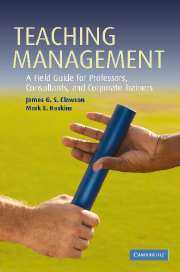Book contents
- Frontmatter
- Contents
- List of figures
- Sources to chapter quotations
- Why this book on teaching management?
- 1 Fundamental elements in teaching
- 2 Levels of learning: one, two, and three
- 3 Adult learning theory: it matters
- 4 Planning a course: trips and tips
- 5 Planning a class: no detail is too small
- 6 Lecturing: the possibilities and the perils
- 7 Managing discussions
- 8 Case method: fostering multidimensional learning
- 9 Role-playing
- 10 Case writing: crafting a vehicle of interest and impact
- 11 Case teaching notes: getting from here to there
- 12 Action learning
- 13 Experiential methods
- 14 Enhancing the conversation: audiovisual tools and techniques
- 15 Executive education: contributing to organizational competitive advantage
- 16 Using technology to teach management
- 17 Counseling students
- 18 Evaluating students: the twin tasks of certification and development
- 19 Teaching evaluations: feedback that can help and hurt
- 20 Research presentations
- 21 Managing a degree program: behind the ‘glory’
- 22 Managing a nondegree client program: an overview
- 23 Dealing with the press
- 24 Managing yourself and your time
- 25 Using teaching portfolios and course portfolios
- 26 Conclusion: is this on the exam?
- Index
4 - Planning a course: trips and tips
Published online by Cambridge University Press: 25 February 2010
- Frontmatter
- Contents
- List of figures
- Sources to chapter quotations
- Why this book on teaching management?
- 1 Fundamental elements in teaching
- 2 Levels of learning: one, two, and three
- 3 Adult learning theory: it matters
- 4 Planning a course: trips and tips
- 5 Planning a class: no detail is too small
- 6 Lecturing: the possibilities and the perils
- 7 Managing discussions
- 8 Case method: fostering multidimensional learning
- 9 Role-playing
- 10 Case writing: crafting a vehicle of interest and impact
- 11 Case teaching notes: getting from here to there
- 12 Action learning
- 13 Experiential methods
- 14 Enhancing the conversation: audiovisual tools and techniques
- 15 Executive education: contributing to organizational competitive advantage
- 16 Using technology to teach management
- 17 Counseling students
- 18 Evaluating students: the twin tasks of certification and development
- 19 Teaching evaluations: feedback that can help and hurt
- 20 Research presentations
- 21 Managing a degree program: behind the ‘glory’
- 22 Managing a nondegree client program: an overview
- 23 Dealing with the press
- 24 Managing yourself and your time
- 25 Using teaching portfolios and course portfolios
- 26 Conclusion: is this on the exam?
- Index
Summary
Let our children grow tall, and some taller than others if they have it in them to do so.
– Margaret Thatcher, former British Prime MinisterAt a very fundamental level, dreaming about, then designing a framework for, then developing the content of, and then delivering the classes in, a course is one of the more entrepreneurial activities an instructor does. For a brand-new course, it may occur only a handful of times over the span of a career. It occurs repeatedly, albeit in a slightly different way, when you conscientiously revisit and revise a course that may be going into its twenty-seventh offering. In either instance, course planning is akin to mapping a road trip – identifying the destination, knowing the students' “you-are-here” position, choosing the best vehicle(s) for the journey, identifying the best routes, selecting the most conducive speed to travel, and highlighting the memorable scenes along the way that all contribute to a strong, lasting, effective learning experience for students. Indeed, it is about creating a journey that invites and entices students to experience and internalize as much of the trip as they possibly can so that they learn and, to use Thatcher's analogy, grow as tall as they can.
Course planning is about…
Anticipation
Planning a course, at its most basic level, brings to bear an instructor's best thinking about how to craft an effective learning experience for students.
Information
- Type
- Chapter
- Information
- Teaching ManagementA Field Guide for Professors, Consultants, and Corporate Trainers, pp. 49 - 70Publisher: Cambridge University PressPrint publication year: 2006
